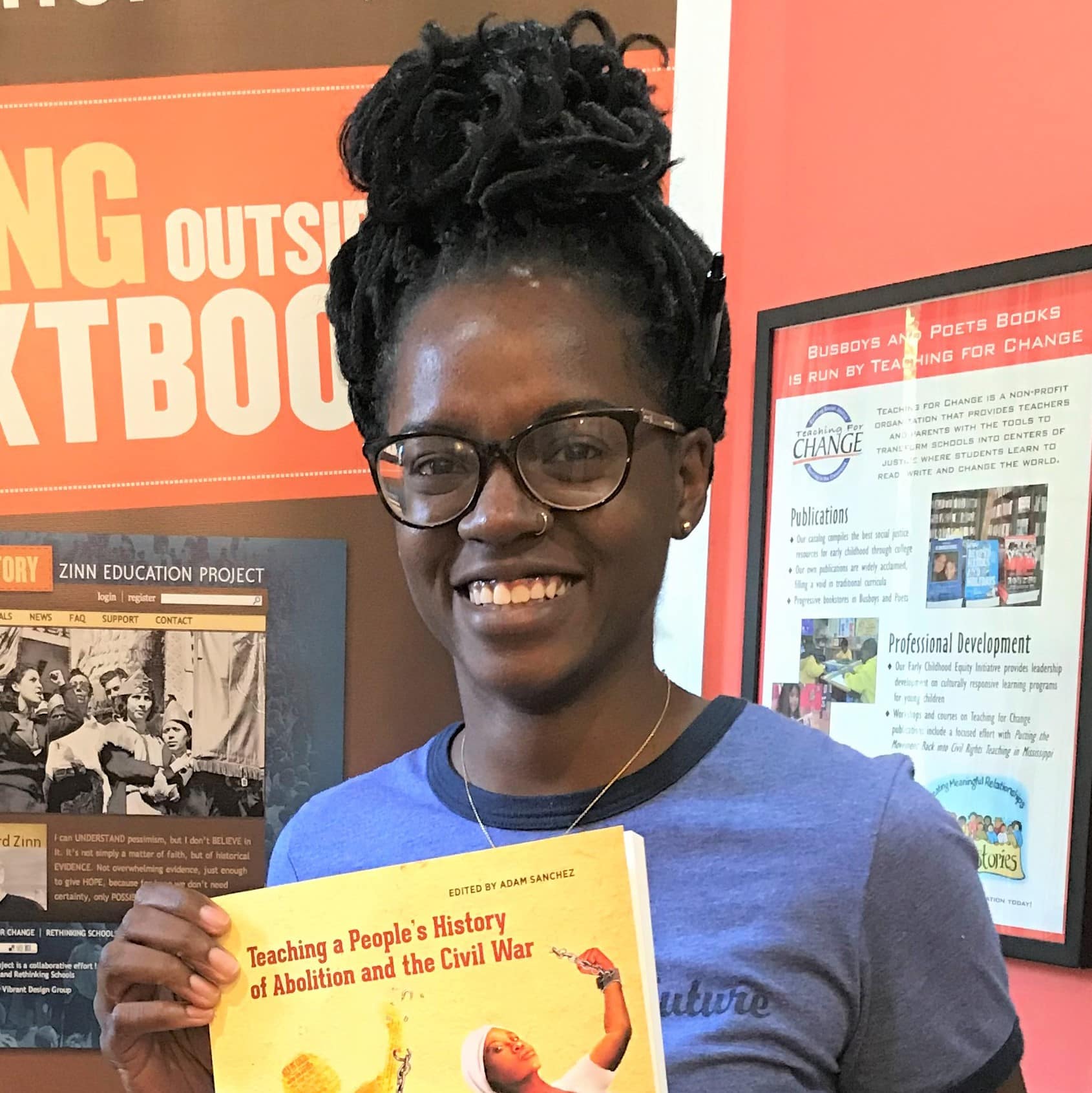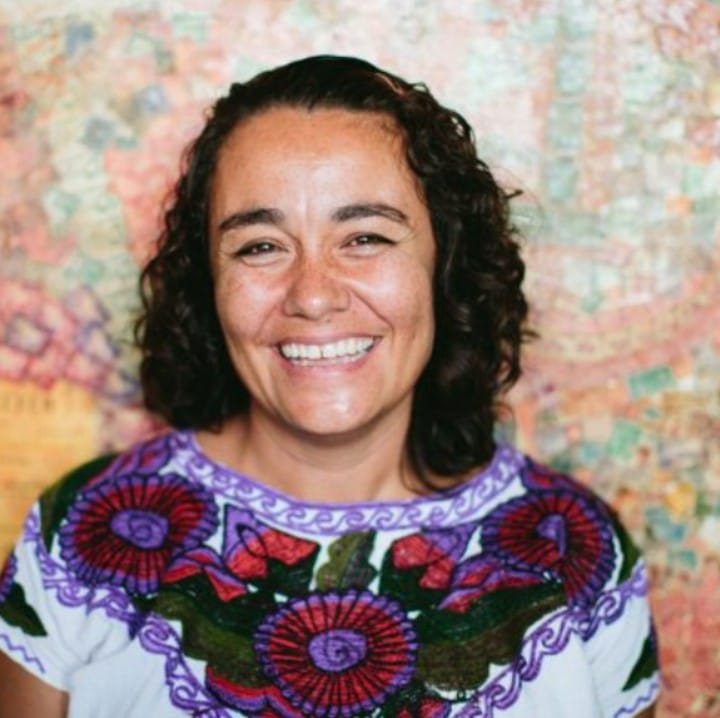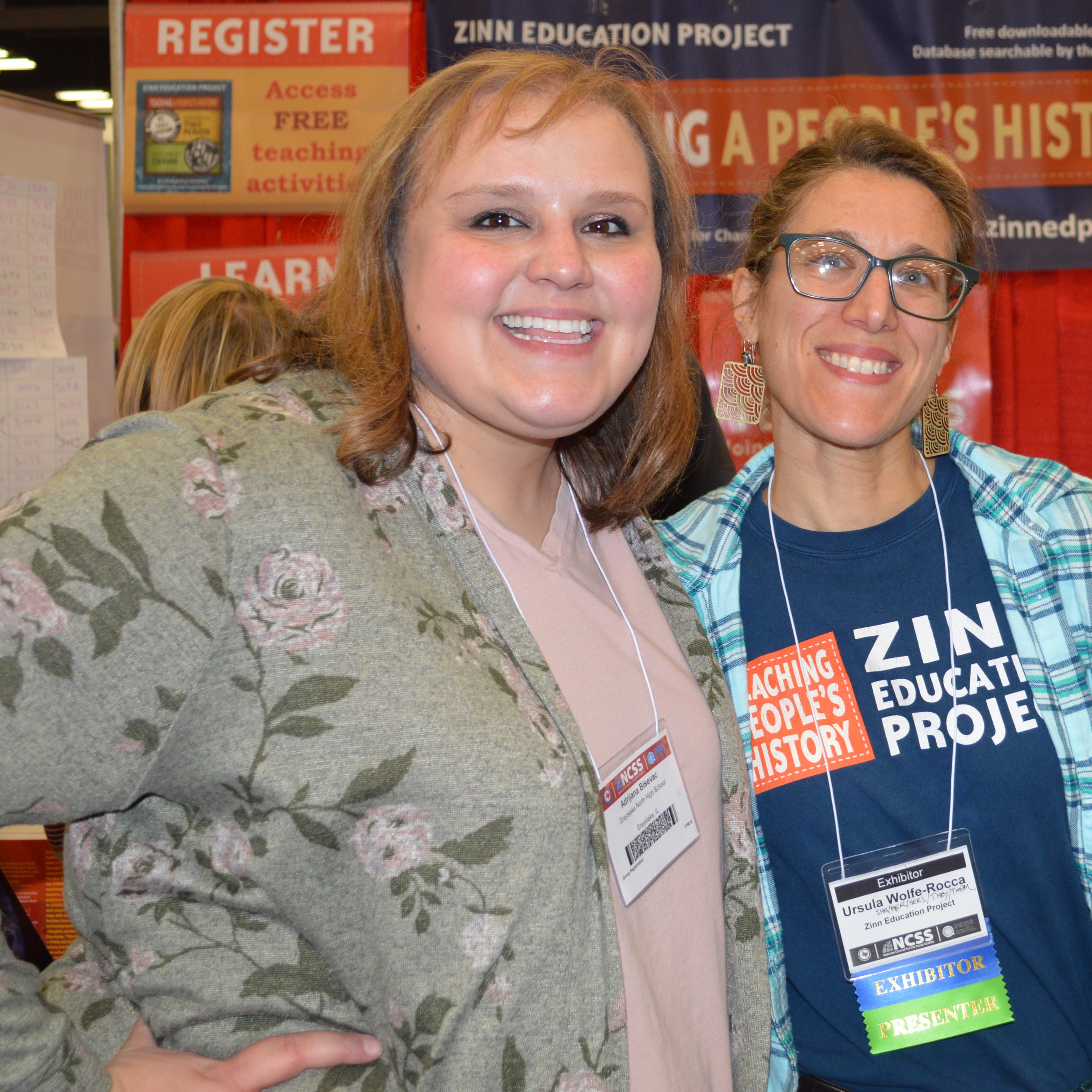Here are a few of the countless stories we have received from the more than 150,000 teachers who have accessed lessons from the Zinn Education Project website. They speak to the power of teaching people’s history.
The right is trying to ban this history and accusing us of making students ashamed. Quite the contrary. Teaching people’s history helps students understand the root causes of injustices today and provides them the tools and inspiration to shape a better future.
The stories that follow make clear the benefits of teaching outside the textbook, beginning with short clips from teachers at the 2022 National Council for the Social Studies conference.
View this post on Instagram
View this post on Instagram
View this post on Instagram
View this post on Instagram
Teacher Contributors
For many teachers, the Zinn Education Project resources mean so much to them that they become contributors, including the two below. Join them with a donation.

I am donating to the Zinn Education Project in honor of all the educators in my family. Especially my great-grandfather London Williams who contributed funding and land for Morris College, a HBCU in Sumter, South Carolina.
[Learn about Nelva Williamson’s history as an educator in this Storycorps segment.]
I’m donating to the Zinn Education Project as a U.S. History teacher who has benefited from the people’s history lessons and people’s history classes online. The lessons are amazing and get my students far more engaged than anything else. The online classes have also provided the opportunity to learn and collaborate in community with like-minded educators across the country who believe in teaching truth!
Finally, I’m donating in honor of my mother Catherine Billingsley, who died in 2017. She was a teacher for over 30 years in rural Arkansas. She believed in the power and importance of education her whole life and passed that belief to me. I’m proud to be teaching people’s history!
Teacher Stories by Theme
Teachers often share stories about a particular lesson. We offer selected examples by theme. Find many more on the pages of our respective lessons and at What Teachers Are Saying.
Civil Rights Movement

We did the Teaching SNCC lesson, where students have a SNCC (Student Nonviolent Coordinating Committee) meeting to discuss plans and make decisions based on real historical events. I wish people could see how the kids were really strategizing and getting into their roles as SNCC members.
It was so encouraging to me as a teacher to see my students understand the grassroots organizing of the Civil Rights Movement. However, it was even more rewarding to watch them engage with the material in a social, emotional, and critical way. They are not only learning history, they are learning skills that can be applied to real-life scenarios.

I used the first lesson in the unit, Who Gets to Vote? Teaching the Struggle for Voting Rights in the United States, in my United States government course. It fostered great conversation and insight for my students in considering the importance of voting and factors that hinder voting (especially educated voting). My students hadn’t much considered the importance of voting, and some were despairing about the worth of their vote following my lesson on the Electoral College.
Fannie Lou Hamer’s excerpts, especially the second excerpt, revealed to my students something that they hadn’t previously considered: while they didn’t see value in their vote, they hadn’t considered the challenges that have historically and contemporarily prevented citizens from the ability to vote in the first place.
This lesson led my students to reconsider the value of their voice in federal and local elections. I taught it on election day and I believe that it inspired many of them to vote in the election, some of whom left for the polls straight from school! Thank you, as always, for your great resources!
Climate Justice

We used materials from the Zinn Education Project, Rethinking Schools, and Teaching for Change with our 7th grade to create an interdisciplinary, experiential project that explored Indigenous Perspectives on Climate Change. It was the perfect way to tie together our humanities unit on Indigenous Perspectives on American History with the STEM unit on deep time and extinction-level events.
Our students prepared for the ‘Don’t Take Our Voices Away’ indigenous people’s climate summit simulation as a final learning demonstration. Taking on the perspectives of various indigenous groups was something our students took seriously as they researched both the cultures and climate challenges faced by the groups. Then, at the summit, they did presentations that explained the priorities and needs of those groups before launching into negotiations about how to best communicate those perspectives with the rest of the world.
Leading up to the summit, we took a climate justice gallery walk using photos shared on the ZEP website, researched indigenous climate activists, and also did the Meet Today’s Climate Justice Activists mixer. Those activities were the perfect scaffold to the summit. Overall, I saw my students develop deep understanding and empathy through the interactive and experiential materials provided by the Zinn Education Project.
I am grateful to have participated in a workshop where I learned how to use them. Now that I am at a school where our model centers experiential project based learning, these materials have become an invaluable resource.
   |
I chose to do Food, Farming, and Justice: A Role Play on La Vía Campesina with seniors in International Issues, where they completed the role play for their midterm exam. Our course uses the critical lenses of racism, imperialism, capitalism, and the climate crisis to investigate human rights issues. So, this role play has been a perfect supplement to our work. The materials are so well-designed, thoughtful, challenging, yet accessible, that all of my students have been 100% engaged. Students were so engrossed in the mixer at the beginning of the lesson that they responded with cries of “No! You can’t make us stop!” when I told them class was ending and we could continue our work during the next class. Thank you Zinn Education Project. Your materials help me to be a better teacher and they help my students have more meaningful and memorable experiences in the classroom. |
Who’s to blame for causing the climate crisis? Ss explore this ? in an experiential role playing activity from @ZinnEdProject called “The Climate Crisis Trial.” Five “defendants” are on trial for the role each played in causing climate change. High-level engagement and thinking! pic.twitter.com/Wuy1bVG5v3
— Brett Benson (@MrBensonNMS) May 3, 2022
Abolition Movement and Resistance to Slavery

Last year, I wanted my students to have a deeper understanding of the legacy of resistance before, during, and after the Civil War. So, I decided to teach the Poetry of Defiance lesson. I wanted to dismantle the idea that African Americans were bystanders in the fight against oppression.
The lesson was so well-received and sparked such great dialogue amongst my students that now I am attempting to use at least one Zinn Education Project lesson during every unit. . . . Continue reading

I used the Black Abolitionist biographies in a lesson where my students explored and learned about resistance to the institution of slavery before the Civil War.
First, we established norms around vocabulary, words that we would use to speak about slavery to shift the language away from dehumanization. Then, we listened to historical narratives from the Museum of the African Diaspora archive from the museum in San Francisco. We looked at the abolitionists’ biographies on the Zinn Education Project website and had a “tea party” where students discussed the person they read about. Finally, we watched the PBS special on William Still and ended the unit with a field trip to see the film Harriet.

Adapting Adam Sanchez’s lesson, Poetry of Defiance: How the Enslaved Resisted, for online learning was a labor of love. The Rethinking Schools/Zinn Education Project’s mixer activities have been a catalyst for understanding in my classroom; I couldn’t imagine any space — even at a distance — that didn’t include that power.
The first hurdle to overcome was the difference in participation between a captive audience in class and students logging in when they can at home. There are the logistics of asynchronous participation which come from any online learning scenario. And there is particular care to be taken specifically during the COVID-19 outbreak, when families are experiencing stress and upheaval at home. . . . Continue reading
COINTELPRO

The Zinn Education Project’s COINTELPRO lesson plan made for a remarkable class session. I used the lesson as a capstone to a Civil Rights/Black Power unit.
While the underlying background sometimes astounded students, it was being able to see the historical narrative grounded in primary source documentation — to see a story that might seem beyond belief for some of them — that really inspired them to pay closer attention to their work.
They dug into and debated every paragraph of every document! It was an energy boost, new fuel for their thinking and communicating, for the remainder of the semester.

I was incredibly impressed with the materials presented during a workshop on the Civil Rights Movement and a COINTELPRO lesson by the Zinn Education Project during the NCSS conference in 2018. Since then, I have used facets of that specific lesson, such as the sources on the Black Panthers, in class to spark discussions with my students.
I was so happy I discovered both the Zinn Education Project and this lesson, in particular. It provides a different lens that I had not previously given to my class, regarding the Black Panthers. The lesson as a whole allows for links to current events and issues in today’s society as well.
The Zinn Education Project has helped me to expand my understanding of United States History. I was first introduced to them at the NCSS conference in Chicago back in 2018 and I was impressed by the passion that they have for sharing the parts of history that traditionally go untold.
The people’s history lessons have become one of my favorite tools for my classroom. (A personal favorite of mine is their COINTELPRO lesson.) Their lesson writers are able to create engaging activities for the classroom that are also incredibly practical.
Reconstruction

My experience learning about the Reconstruction Era in school (which I’m sure was like most people’s) centered around the Reconstruction Amendments and the actions of the President and Congress.
As a teacher, I wanted to go beyond the amendments to introduce my students to the individuals who were involved in the abolition movement and the fight for equality and justice.
The Reconstruction Mixer lesson did just that. Students took on roles of people involved not just in the abolitionist movement but also in the women’s rights and union workers’ movement. It’s a good day when students know the names and stories of people who fought for justice in their community and their nation.
The diversity of the people included in the activity led to some interesting conversations. In our post-mixer discussion, students spoke up about the tensions between different movements, especially the abolitionist and women’s rights movements.
My class delved into a deeper conversation about what to do when you don’t get what you are fighting for — do you support the other movements or do you stand firm and focus on only what you want? This is a discussion we would not have had if we had just looked at the Reconstruction Amendments and the actions of the people at the top! I will definitely be doing this lesson again in my class.

When I started planning this year’s U.S. History course at Harwood Union High School in Duxbury, Vermont, I started “from the ground up,” meaning with the grassroots and with the stories and experiences of the actual people who lived here before Europeans. All year, I have continued to help students learn to “read” histories as stories, told by various people, but usually by “the winners.” Our guiding question for the year concerns not “history(ies)”, but the past. The actual past as it happens, which takes more work, and it takes breaking with conventional myths and texts.
Reading A People’s History of the United States almost 30 years ago changed my life and helped me break with those myths and texts and how I understood the world. It also influenced me as a journalist in the United States and Haiti.
I wanted to offer my students the same inspiration and ongoing epiphany (or series of epiphanies) and so I’ve been putting in many extra hours revisiting the work of Howard Zinn and others and also discovering new resources.
In the fall, we spent some five weeks studying Native American nations, oppression and resistance, and then proceeded to settler-colonialism and so on. The lessons and activities would not have been possible without this website, Voices of a People’s History, articles by Bill Bigelow, and a few other sources . . .
When the Teach Reconstruction report emerged, I was blown away. Together, the students and I radically altered the syllabus and we spent about three weeks on this period, watching parts of documentaries, reading some Eric Foner, some primary sources, and parts of the report.
Finally, I gave students an assignment that involved lobbying our department about the importance of teaching a specific topic: either Reconstruction, or one of the other crisis-level issues we’d been studying — gerrymandering, Citizens United, voter suppression, and a few other similar issues. Most chose Reconstruction.
Students were invited to either write a letter to everyone in the department with an accompanying draft lesson plan, or create a “persuasive poster” with additional information online via a QR code. Below are some of the posters.

I currently teach U.S. History I and II to 10th and 11th graders, respectively. We wrapped up our semester this week by holding midterm exams. In lieu of a traditional exam for one of my U.S. History I classes, I had them complete the Zinn Education Project activity “How We Remember.” I had read Clint Smith’s book last year and was blown away by how the history is handled at many of the highlighted locations and his extreme attention to detail.
I’ve since used excerpts from Smith’s book in class, but this activity really had the students use the text in a way that required them to interact with the sites, as well. The commemorations were thoughtful and the students did an incredible job bringing justice to the history of enslavement at those locations. Here are some examples:
The students who were assigned New York City created three works of art to display in Central Park as a way to commemorate work of Black abolitionists and Seneca Village. One work of art was a 3-D rendering of a bed with turned down bedding and a doll on the floor. It was meant to signify the upending and displacement of the Seneca Village community.
The students who were assigned Angola created a script for a guided tour. They included images and provided visuals to go along with the script. The brutal facts of Angola as a plantation and as a prison were presented. In the end, “visitors” were encouraged to sign a petition to close Angola. The plan was to make it a museum that focuses on the history of Black Americans’ struggles both during and after enslavement.
The students who were assigned Monticello created a sculpture which highlighted a number of the enslaved at the plantation. The sculpture included silhouettes of mothers and fathers and beads to represent their children. The purpose was to highlight family separation. On the top of the sculpture was a representation of Monticello; placing it on top of the enslaved was meant to demonstrate the fact that Monticello and Jefferson’s success came at the expense of the enslaved.
Thank you for such an engaging and important activity. I look forward to using it again in the future.

I have been teaching 7th grade history (supposed to be from Jamestown to Reconstruction) for five years. Every year, 7th grade teachers would run out of time and would end with the Civil War. The students would leave thinking, “Hooray! The Union won! Slaves are free! Life is perfect!” They would start 8th grade after Reconstruction — so our students completely missed one of the most important eras of history that still impacts our world today.
I made it my mission to teach Reconstruction.
I found the Zinn Education Project website and the lesson plan Reconstructing the South. From the clear lesson plan, my students were able to empathize and understand the experiences of the freed people during Reconstruction.

Reconstructing the South is a great lesson for helping students understand the history of Reconstruction and also how myths surrounding Reconstruction influence how many people look at Reconstruction history today.
The Lost Cause Mythology has held a grip of falsehood on American “memory” for much of the 20th and now into the 21st century.
This lesson from the Zinn Education Project help students to understand the role of African Americans in the post-Civil war south and how white southerners actively worked to end these gains.

Reconstructing the South is an excellently planned role play — the questions and the sources really got students engaged in the moment of possibility around Reconstruction, rather than looking back on history as “an important lesson” but one that was predestined to turn out specific way. Students of all skill levels were hotly debating these issues, and were eagerly citing evidence to support their positions. One group of students went so far as to calculate a daily wage for freedmen and women to be paid if they agree to farm part of their land with cash crops for the government, and then attempted to convert the amount into its 1875 equivalent!
Students tied the activity into the next part of our unit around change into the Civil Rights Era, and studied the Montgomery Bus Boycott and Claudette Colvin, and now are engaged in the Black Panther Party. The activity really helped me as a teacher (still in my first year!) think about what makes awesome historical thinking questions that center the counter-narratives in American History. Awesome resource and I highly recommend to teachers. The only thing I feel could be improved is some suggested scaffolds for language learners in terms of the source documents.
Colonialism
Lena Amick in Baltimore describes the impact of teaching our popular People vs. Columbus, et al. lesson in the form of a trial.

I love how “the system of empire” is one of the options for students to blame or defend. This has generated some of the most challenging discussions I’ve seen in my class so far, as students say, “The king and queen would not have sent Columbus if they hadn’t been acting within the system!” and retort, “But the system is made up of individuals, and each have their own choices!”
This thinking about structure vs. agency is a level of thinking in social studies that was not made explicit to me until college.
Your resources truly fill a well left dry — not by forgetfulness, but by the same racist systems that perpetuate the injustices my students face on a daily basis in schools.
Many More Teacher Stories
Find many more teacher stories on our What Teachers Are Saying page and on the pages for most of the lessons.
We Need Your Support
Teachers are under attack for teaching truthfully about U.S. history. end of year donations so that we can continue to offer free people’s history lessons and defend teachers’ right to use them.











Twitter
Google plus
LinkedIn